The Iran Update provides insights into Iranian and Iranian-sponsored activities abroad that undermine regional stability and threaten US forces and interests. It also covers events and trends that affect the stability and decision-making of the Iranian regime. The Critical Threats Project (CTP) at the American Enterprise Institute and the Institute for the Study of War (ISW) provides these updates regularly based on regional events. For more on developments in Iran and the region, see our interactive map of Iran and the Middle East.
Note: CTP and ISW have refocused the update to cover the Israel-Hamas war. The new sections address developments in the Gaza Strip, the West Bank, Lebanon, and Syria, as well as noteworthy activity from Iran’s Axis of Resistance. We do not report in detail on war crimes because these activities are well-covered in Western media and do not directly affect the military operations we are assessing and forecasting. We utterly condemn violations of the laws of armed conflict and the Geneva Conventions and crimes against humanity even though we do not describe them in these reports.
Click here to see CTP and ISW’s interactive map of Israeli ground operations. This map is updated daily alongside the static maps present in this report.
Key Takeaways:
- A Muslim Brotherhood-affiliated organization invited Hamas Political Bureau Chairman Ismail Haniyeh to deliver a major speech at its General Assembly in Doha. Haniyeh laid out his most comprehensive argument to date about Hamas’ October 7 attack into Israel and appealed for donations and weapons transfers.
- The al Qassem Brigades—the militant wing of Hamas—claimed several attacks on Israeli forces in the northern Gaza Strip.
- The Israel Defense Forces continued clearing operations in Maghazi and Bureij in the Central Governorate of the Gaza Strip.
- Israeli forces expanded clearing operations in some urban areas of southern Khan Younis City. Palestinian militias continued attempting to defend against Israeli clearing operations Khan Younis.
- Israeli and Egyptian delegations met in Cairo to discuss resuming talks on the release of hostages and a ceasefire agreement.
- Palestinian militias conducted two indirect fire attacks into Israel from the Gaza Strip.
- Israeli forces clashed with Palestinian fighters in nine locations across the West Bank.
- Lebanese Hezbollah conducted a one-way drone and rocket attack targeting the IDF Northern Command headquarters in Safed, Israel. Iranian-backed militias, including Lebanese Hezbollah, conducted nine other attacks from southern Lebanon into northern Israel.
- The Israel Defense Forces killed Lebanese Hezbollah Air Force Commander for Southern Lebanon Ali Hussein Burji in an airstrike in southern Lebanon.
- Israeli Defense Minister Yoav Gallant reiterated that Israel’s top priority is enabling displaced Israeli citizens to return to their homes in northern Israel in a meeting with US Secretary of State Antony Blinken.
- The Iraqi federal government continues to fail to protect US forces, who are deployed to fight the Islamic State, from Iranian-backed militia attacks while also rejecting the United States’ right to defend its servicemembers in Iraq. Politico reported that senior advisers to the Iraqi prime minister privately told US officials that he seeks to keep US forces in Iraq.
- Kataib Hezbollah spokesperson Jafar al Husseini warned that Iranian-backed Iraqi militias would help Lebanese Hezbollah fight Israel if war erupted between Israel and Hezbollah.
- The Jordanian Royal Air Force conducted airstrikes targeting Iranian-linked drug smuggling operations in southern Syria. This airstrike is part of growing Jordanian operations against these smuggling networks.
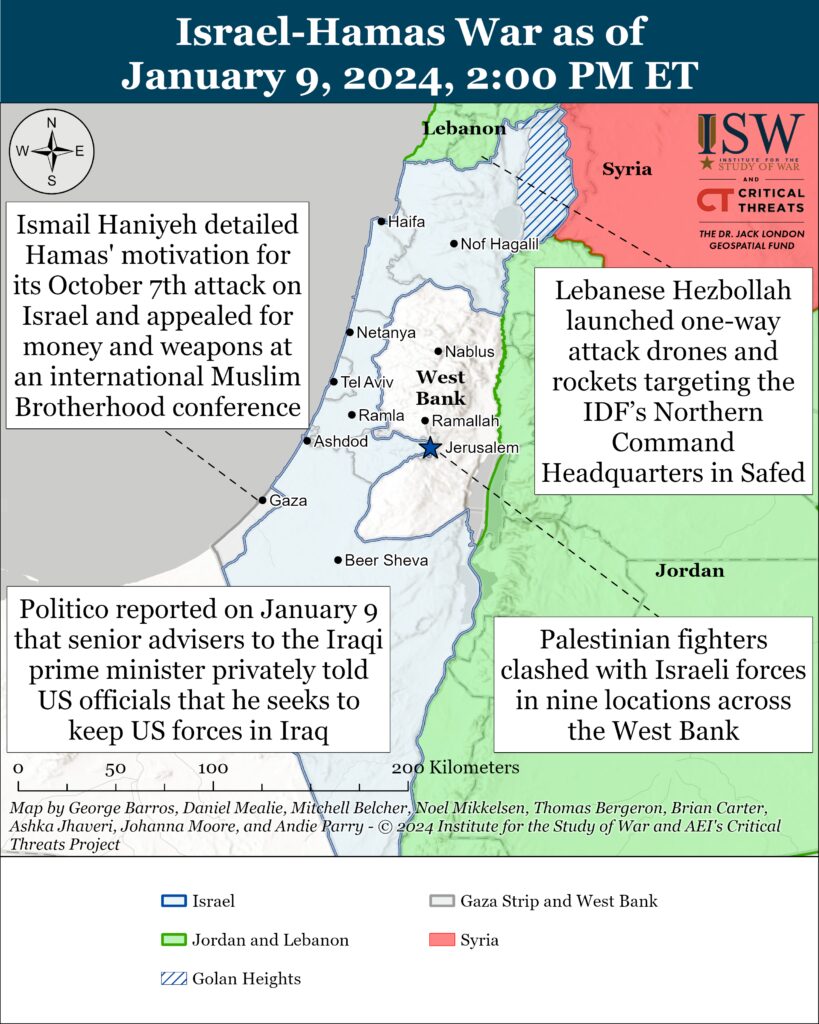
A Muslim Brotherhood-affiliated organization invited Hamas Political Bureau Chairman Ismail Haniyeh to deliver a major speech at its General Assembly in Doha on January 9.[i] Haniyeh spoke at the International Union of Muslim Scholars’ “Al Aqsa Flood and the Role of the Ummah” conference.[ii] A senior Muslim Brotherhood scholar founded the International Union of Muslim Scholars in 2004 in Dublin. The scholar later moved the organization to Qatar.[iii] Anti-Muslim Brotherhood countries, such as Saudi Arabia, Egypt, the United Arab Emirates, and Bahrain, have listed the organization’s founder on their terror lists before his death.[iv] Hamas released pictures of Haniyeh seated beside the organization’s president, highlighting Haniyeh’s prominence at the conference.[v]
Haniyeh laid out his most comprehensive argument to date about Hamas’ October 7 attack into Israel and appealed for donations and weapons transfers during his speech.[vi] He claimed that Hamas was forced to employ “non-traditional means” against Israel due to 1) the local and international marginalization of the Palestinian issue, 2) the election of an “extremist” Israeli government that wanted to further displace Palestinians and control the al Aqsa Mosque, and 3) the regional normalization and integration of Israel.[vii] Other Hamas officials have made similar arguments about the regional and international marginalization of the Palestinian issue since October 7.[viii] Haniyeh framed supporting Hamas as a religious duty and asked the international audience at the conference to give Hamas financial and military support[ix] He also called for the conference attendees to form delegations to lobby governments in their respective countries to support Hamas.[x]
Haniyeh also reiterated Hamas’ negotiating position. Haniyeh said that Hamas’ hostage negotiation position remains “all for all,” meaning that Hamas wants Israel to release all its Palestinian prisoners in exchange for Hamas releasing the Israeli hostages.[xi] He also claimed Israel that had not freed a single hostage alive through military means in the Gaza Strip.[xii] Hamas and Palestinian Islamic Jihad (PIJ) have repeatedly emphasized that Israel’s ground and air campaign in the Gaza Strip is killing Israeli hostages rather than freeing them.[xiii] Haniyeh asserted that Hamas’ command-and-control networks remain strong and cohesive.[xiv] CTP-ISW has contrastingly assessed that Hamas faces command-and-control issues with its fighters in some areas of the Gaza Strip.[xv] The Israel Defense Forces (IDF) said that it has ”dismantled” 12 Hamas battalions in the northern Gaza Strip, and an Israeli “surgical strike” killed Haniyeh’s deputy, Saleh al Arouri, in Beirut on January 2.[xvi] Haniyeh claimed that Israel’s objective to destroy Hamas is unattainable, primarily because ”Hamas exists in Gaza, the West Bank, Jerusalem, and in the diaspora.”[xvii]
Gaza Strip
Axis of Resistance campaign objectives:
Erode the will of the Israeli political establishment and public to launch and sustain a major ground operation into the Gaza Strip
Degrade IDF material and morale around the Gaza Strip.
The al Qassem Brigades—the militant wing of Hamas—claimed several attacks on Israeli forces in the northern Gaza Strip on January 9. The al Qassem Brigades fired small arms, mortars, and rocket-propelled grenades (RPG) at Israeli dismounted infantry and vehicles in Zaytoun.[xviii] The group published an undated video on January 9 that showed an al Qassem Brigades fighter detonating an explosively formed penetrator (EFP) from a tunnel, targeting Israeli forces in Zaytoun.[xix] The al Qassem Brigades also said that it exploded two tunnel entrances south of Zaytoun as Israeli forces approached them.[xx]
The IDF continued clearing operations in Maghazi and Bureij in the Central Governorate of the Gaza Strip on January 9. The IDF Golani Brigade (assigned to the 36th Division) directed an airstrike in Maghazi targeting al Qassem Brigades fighters in Hamas’ Central Gazan Brigade.[xxi] The al Qassem Brigades said that it fired sniper rifles targeting Israeli forces east of the Bureij refugee camp.[xxii] The al Quds Brigades—the militant wing of PIJ—claimed separately that it fired RPGs targeting Israeli forces east of the Bureij refugee camp.[xxiii] The al Quds Brigades also published a video on January 9 that shows its fighters firing mortars targeting Israeli dismounted infantry and vehicles in the eastern and northern areas of the central Gaza Strip.[xxiv]
Israeli forces expanded clearing operations in some urban areas of southern Khan Younis City on January 9. The al Qassem Brigades began claiming attacks on Israeli armor and dismounted infantry south of Khan Younis City on January 9.[xxv] Commercially available satellite footage shows flattened terrain that is consistent with the movement of Israeli armor in southern Khan Younis City. Israeli forces frequently use bulldozers to clear terrain to establish defensible positions in urban environments in the Gaza Strip. The IDF published videos on January 9 that showed its troops “deepening the operational grip in the south of the Gaza Strip” on January 9.[xxvi] Israeli Defense Minister Yoav Gallant told US Secretary of State Antony Blinken on January 9 that the IDF would intensify its operations in the southern Gaza Strip until it frees hostages and kills Hamas leaders.[xxvii]
Israeli clearing operations in Khan Younis destroyed Palestinian militant infrastructure and weapons on January 9. The IDF 98th Division killed approximately 40 Palestinian fighters and located tunnel shafts and weapons caches during clearing operations in Khan Younis.[xxviii] The IDF Givati Brigade captured Hamas ammunition, small arms, and paraphernalia during a raid targeting the Islamic University in Khan Younis.[xxix] The brigade also located near the university weapons caches that contained about 100 mortars, four EFPs, grenades, and Hamas battle maps.[xxx] The 900th Kfir Brigade Combat Team ([BCT] Assigned to the 99th Division) clashed with Palestinian fighters as the BCT raided buildings containing weapons.[xxxi] The Maglan Unit captured small arms, grenades, ammunition and Hamas intelligence and military manuals in civilian homes in Khan Younis.[xxxii]
Palestinian militias continued attempting to defend against Israeli clearing operations Khan Younis on January 9. The al Qassem Brigades claimed attacks on Israeli armor and dismounted infantry south and east of Khan Younis City.[xxxiii] The spokesperson of the al Aqsa Martyrs Brigades—the self-proclaimed militant wing of Fatah—said on January 9 that its fighters had conducted 25 ”combat missions” with a range of weapons against Israeli forces in central and eastern Khan Younis.[xxxiv] The al Quds Brigades mortared an Israeli field headquarters northeast of Khan Younis.[xxxv] The al Quds Brigades also targeted Israeli infantry in a house with thermobaric grenades and small arms.[xxxvi] The National Resistance Brigade—the militant wing of the Democratic Front for the Liberation of Palestine (DFLP)—detonated an IED targeting Israeli forces during fighting in central Khan Younis.[xxxvii]
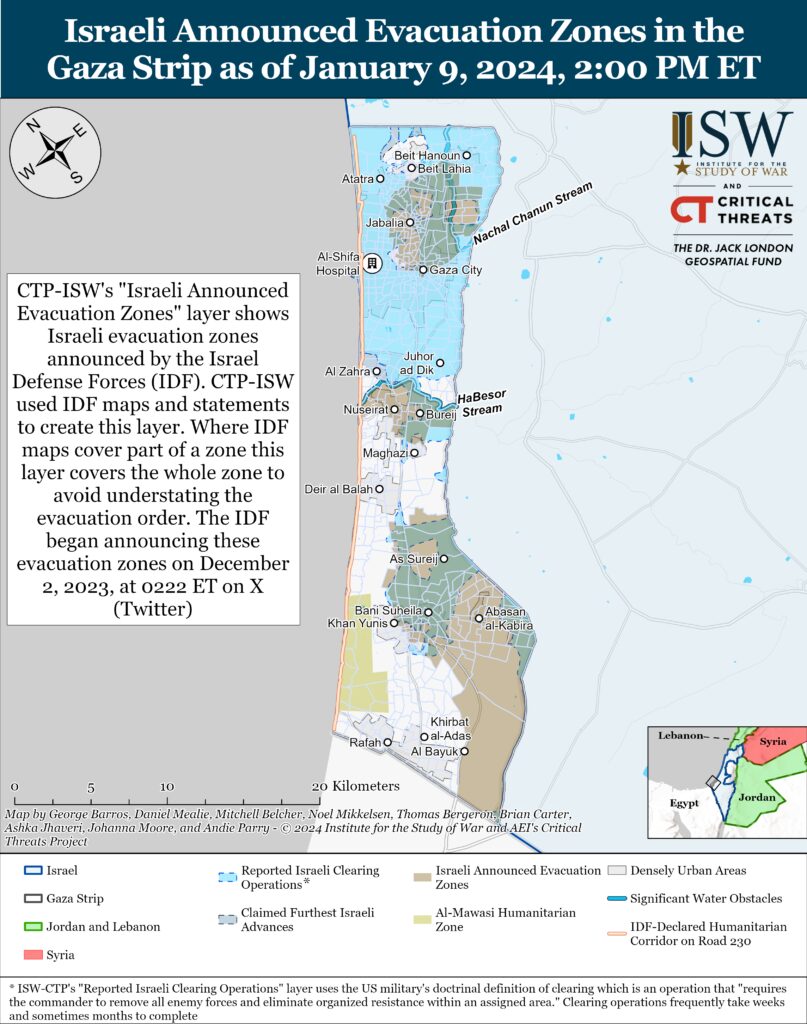
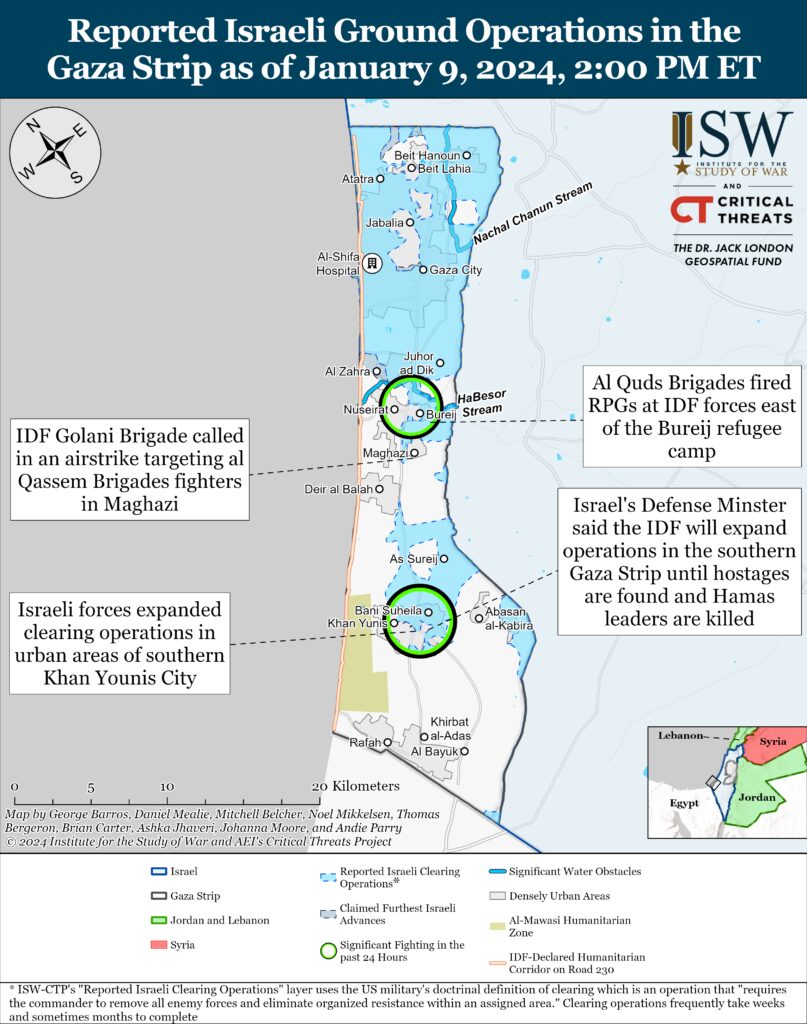
US Secretary of State Antony Blinken met with Israeli Prime Minister Benjamin Netanyahu and the Israeli War Cabinet in Tel Aviv on January 9.[xxxviii] Blinken stressed the need to avoid civilian harm and protect civilian infrastructure in the Gaza Strip. Blinken and Netanyahu also discussed efforts to release Israeli hostages and increase humanitarian aid to civilians in the Gaza Strip.
ADD NOTE
TWEET
Israeli and Egyptian delegations met in Cairo on January 9 to discuss resuming talks on the release of hostages and a ceasefire agreement.[xxxix] Indirect talks between Israel and Hamas froze on January 2 after Israel killed Hamas Political Bureau Deputy Chairman Saleh al Arouri in Beirut.[xl]
Three senior Egyptian officials told Reuters on January 9 that Egypt rejected an Israeli proposal for combined Israeli-Egyptian monitoring of the Philadelphi Corridor, which is a narrow land route dividing Egypt from the Gaza Strip.[xli] Israeli officials “asked to participate“ in monitoring the corridor with Egypt using new, Israeli-procured monitoring technology. The Egyptian sources said that Egypt is prioritizing a new ceasefire agreement as “the necessary foundation for discussions about post-war Gaza,“ including discussions on the corridor.
The Egyptian position on a ceasefire is similar in some respects to Hamas‘ position on negotiations in that both seek a ceasefire before further discussions on the post-war Gaza Strip. Hamas has repeatedly demanded that Israel agree to a ceasefire and to withdraw its forces from the Gaza Strip before any further discussions on Israeli hostages and the war. The ceasefires proposed by both Hamas and Egypt are incompatible with Israel’s stated war aims, which includes the destruction of Hamas, demilitarization of the Gaza Strip, and “deradicalization of Palestinian society.”[xlii] The ceasefire proposed by Egypt would leave room for Hamas to insert itself into discussions on the post-war Gaza Strip. CTP-ISW assessed on December 28, 2023, that previous Egyptian peace efforts would allow Hamas to influence a post-war Gaza Strip.[xliii]
Palestinian militias conducted two indirect fire attacks into Israel from the Gaza Strip on January 9. The National Resistance Brigades fired rockets barrages at unspecified locations in southern Israel.[xliv] Israeli media separately reported a rocket attack on Sderot.[xlv]
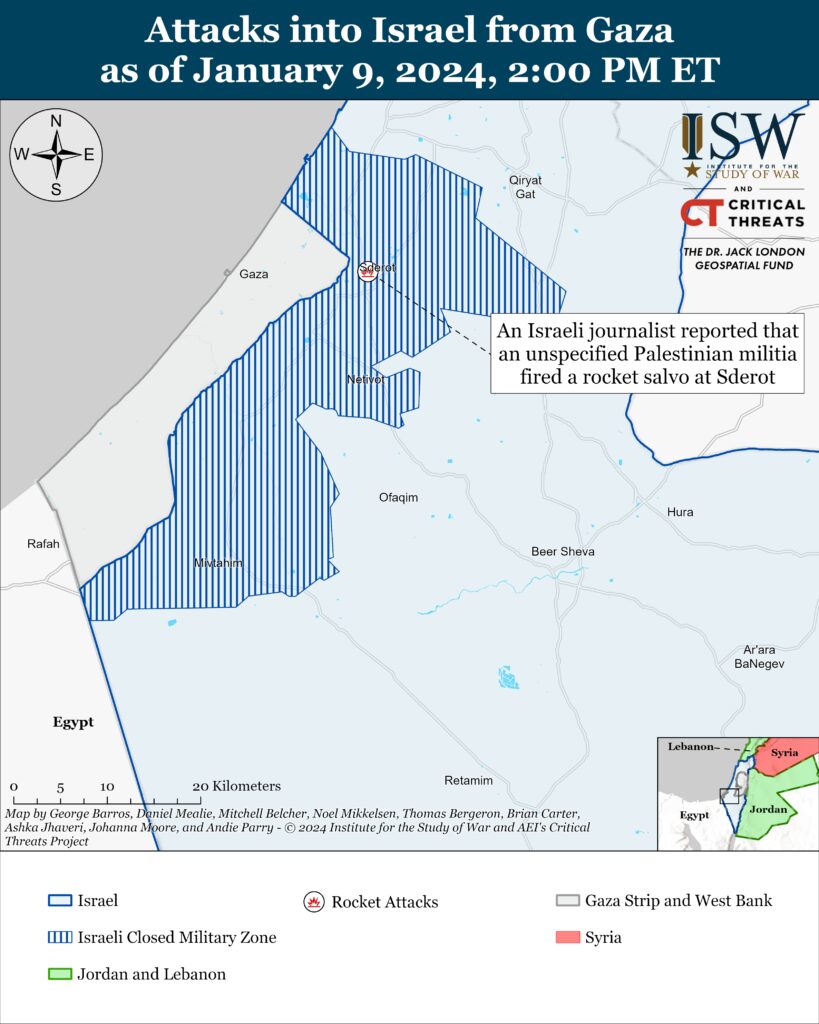
Recorded reports of rocket attacks; CTP-ISW cannot independently verify impact.
West Bank
Axis of Resistance campaign objectives:
Draw IDF assets and resources toward the West Bank and fix them there
Israeli forces clashed with Palestinian fighters in nine locations across the West Bank.[xlvi] The IDF conducted raids in Tulkarm overnight on January 9.[xlvii] The al Aqsa Martyrs’ Brigades claimed that its fighters ambushed Israeli forces in Tulkarm refugee camp, killing and wounding an unspecified number of Israeli soldiers.[xlviii] The Tulkarm Battalion and Rapid Response unit of the al Aqsa Martyrs’ Brigades detonated IEDs targeting Israeli forces in Tulkarm and Tulkarm refugee camp during the raids.[xlix] The al Quds Brigades similarly said that its fighters attacked Israeli forces in Tulkarm refugee camp. The brigades also claimed that it damaged at least one military vehicle during the fighting.[l] The IDF reported that it killed several Palestinian fighters who attacked Israeli troops in Tulkarm on January 9.[li] Several hundred Palestinian men demonstrated during a funeral procession for the fighters. The Palestinian Authority identified the fighters as members of the al Quds Brigades.[lii]
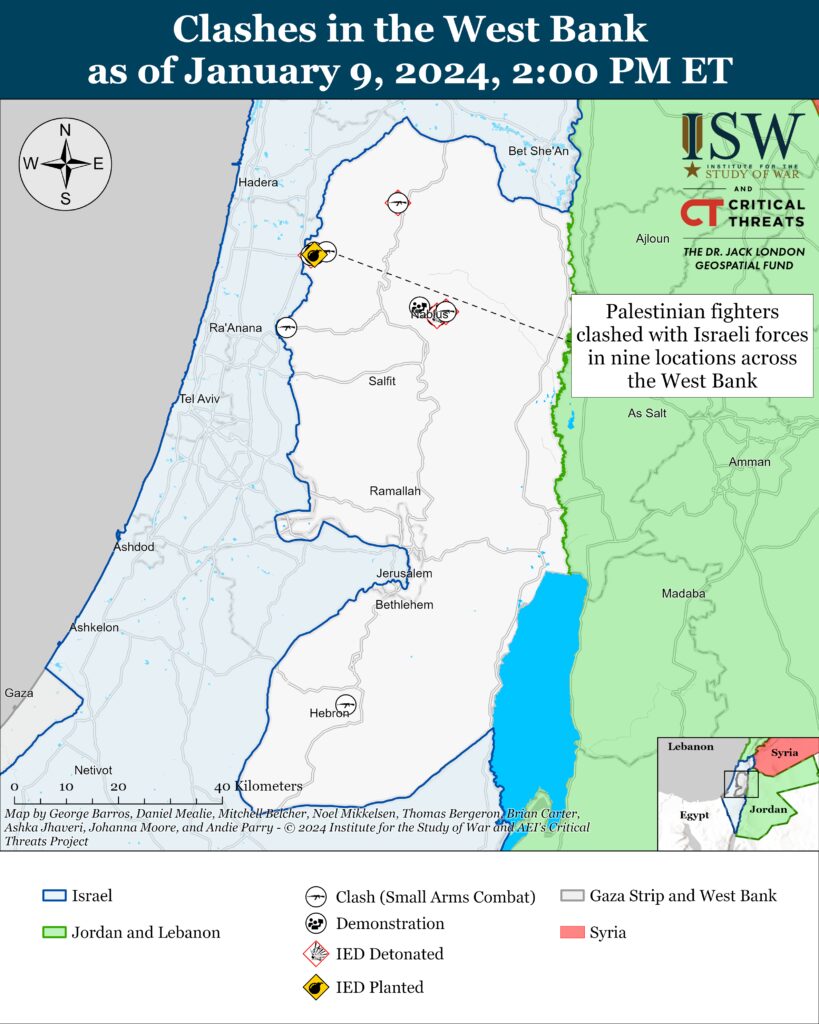
This map is not an exhaustive depiction of clashes and demonstrations in the West Bank.
Southern Lebanon and Golan Heights
Axis of Resistance campaign objectives:
Draw IDF assets and resources toward northern Israel and fix them there
Set conditions for successive campaigns into northern Israel
Lebanese Hezbollah (LH) conducted a one-way drone and rocket attack targeting the IDF Northern Command headquarters in Safed, Israel, on January 9.[liii] LH said that the attack was retaliation for Israel killing Hamas Political Bureau Deputy Chairman Saleh al Arouri and LH Radwan Unit Deputy Commander Wissam Hassan al Tawil on January 2 and 8, respectively.[liv] IDF Army Radio acknowledged that a drone exploded at the IDF Northern Command headquarters but caused no casualties.[lv]
Iranian-backed militias, including LH, conducted nine other attacks from southern Lebanon into northern Israel on January 9.[lvi] LH targeted Israeli forces and military infrastructure and surveillance equipment with anti-tank guided munitions and other unspecified weapons. The IDF conducted airstrikes targeting LH headquarters and other unspecified military infrastructure in Yaroun and Kafr Kila in southern Lebanon.[lvii]
The IDF killed LH Air Force Commander for Southern Lebanon Ali Hussein Burji in an airstrike in southern Lebanon on January 9.[lviii] The airstrike targeted Burji while he attended the funeral for LH Radwan Unit Deputy Commander Wissam Hassan al Tawil.[lix] Israeli media reported that Burji was responsible for dozens of drone attacks into northern Israel since the Israel-Hamas war began, including the January 9 LH attack on the IDF Northern Command headquarters.[lx]
Israeli Defense Minister Yoav Gallant reiterated that Israel’s top priority is enabling displaced Israeli citizens to return to their homes in northern Israel in a meeting with US Secretary of State Antony Blinken on January 9.[lxi] Gallant warned on January 4 that there is little time left for Israel and LH to find a diplomatic solution that would satisfy Israel’s security concerns around the Israel-Lebanon border and allow Israeli citizens to return to their homes in northern Israel.[lxii] Israeli officials have said repeatedly that they aim to find a diplomatic solution to push LH forces north of the Litani River, in accordance with UN Security Council Resolution 1701, but that Israel will resort to military force if diplomatic efforts fail.[lxiii]
Lebanon’s caretaker prime minister, Najib Mikati, told senior UN officials on January 9 that he is ready for talks regarding long-term stability along the Israel-Lebanon border.[lxiv] The Lebanese government has thus far failed to compel LH to implement UNSC Resolution 1701, which ended the 2006 Israel-LH war and mandates LH’s withdrawal north of the Litani River.[lxv]
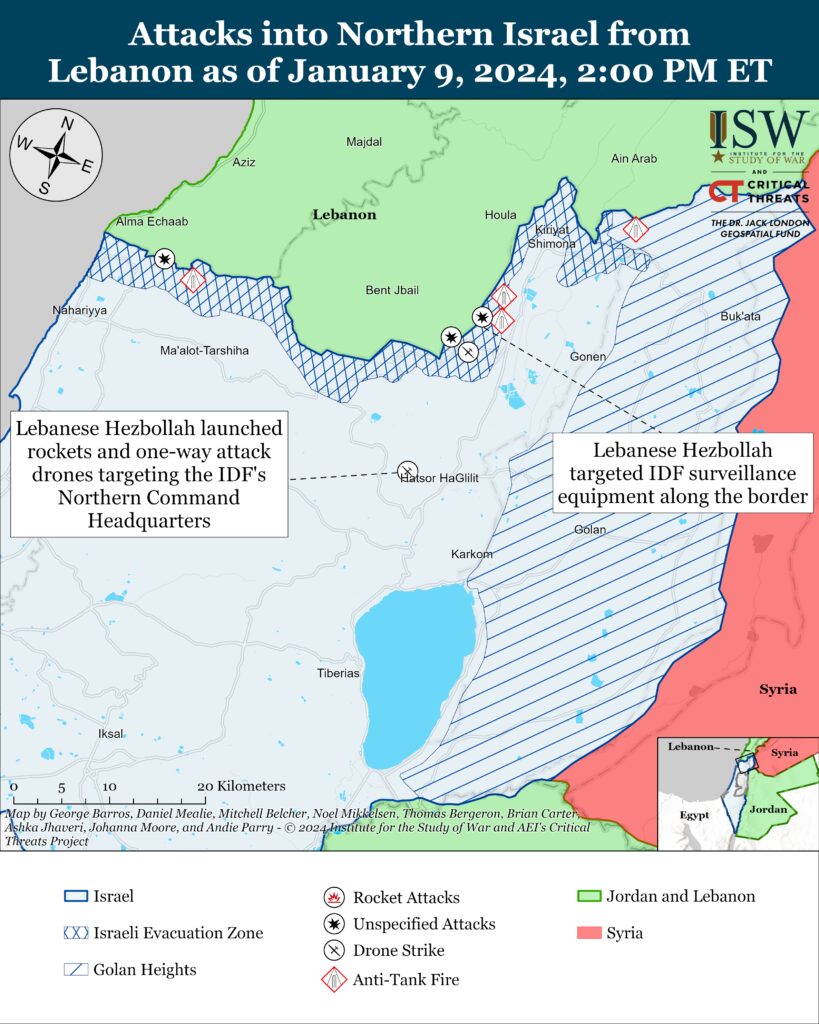
Recorded reports of attacks; CTP-ISW cannot independently verify impact.
Iran and Axis of Resistance
Axis of Resistance campaign objectives:
Demonstrate the capability and willingness of Iran and the Axis of Resistance to escalate against the United States and Israel on multiple fronts
Set conditions to fight a regional war on multiple fronts
The Iraqi federal government continues to fail to protect US forces, who are deployed to fight the Islamic State, from Iranian-backed militia attacks while also rejecting the United States’ right to defend its servicemembers in Iraq.
The United States struck a rocket launcher in al Baghdadi, Anbar Province on January 8 to thwart an attempted Iranian-backed attack on US forces at Ain al Asad airbase.[lxvi] The rocket launcher had at least two rockets prepared to launch toward the base.[lxvii] The Islamic Resistance in Iraq—a coalition of Iranian-backed Iraqi militias—has claimed responsibility for 28 attacks targeting US forces at Ain al Asad airbase since October 2023.
Iraqi President Abdul Latif Rashid met with US Ambassador Alina Romanowski on January 9 to discuss the presence of US-led coalition forces in Iraq.[lxviii] Rashid stated that the presence of US-led coalition forces in Iraq “must be within the framework of supporting the [Iraqi] Security Forces in the areas of training and providing consultations.” Iranian-backed Iraqi actors, including Prime Minister Mohammad Shia al Sudani, have frequently accused the United States of exceeding its advisory capacity and conducting “military actions” that “violate” Iraqi sovereignty.[lxix] These claims ignore the fact that the United States has the right to act in self-defense to protect its forces deployed in Iraq at the invitation of the Iraqi federal government to fight ISIS.[lxx] The United States ended its combat mission in Iraq in December 2021 and currently provides operational and logistical support to the Iraqi Security Forces.[lxxi]
Politico reported on January 9 that senior advisers to the Iraqi prime minister privately told US officials that he seeks to keep US forces in Iraq.[lxxii] Iraqi Prime Minister Mohammad Shia al Sudani formed a committee on January 5 to facilitate the expulsion of US-led coalition forces from Iraq. Politico reported that it “obtained” a January 6 US State Department cable that said that senior Sudani advisers told US officials that he was trying “to satisfy domestic political audiences,” which likely referred at least in part to Iranian-backed militias and political factions. but that Sudani sought to negotiate the US-led coalition’s continued presence in Iraq.[lxxiii]
US Department of Defense Press Secretary Major General Patrick Ryder stated on January 8 that the Iraqi federal government has not notified the department about any decision to expel US forces from Iraq.[lxxiv] Ryder added that the United States does not have any “plans to plan” for the withdrawal of its approximately 2,500 troops from Iraq. Ryder emphasized that the United States remains “very focused on the defeat-ISIS mission.” US forces are present in Iraq for counter-ISIS operations at the invitation of the Iraqi federal government.[lxxv] CTP-ISW previously assessed that an Iraqi decision to expel US forces will very likely create space for ISIS to rapidly resurge in Syria within 12 to 24 months and then threaten Iraq.[lxxvi]
Kataib Hezbollah spokesperson Jafar al Husseini warned that Iranian-backed Iraqi militias would help LH fight Israel if war erupted between Israel and LH during an interview with LH-affiliated outlet al Maydeen on January 9.[lxxvii] Husseini stated that Iraqi militias would be “present in the field in numbers and equipment” and stand “shoulder to shoulder with the Lebanese people” in the event of an Israel-LH war.[lxxviii] Husseini also warned the United States against attacking the Houthis in Yemen.
Husseini added that Iraqi militias will continue to confront US forces in the region even after the end of the Israel-Hamas war.[lxxix] This statement is consistent with CTP-ISW’s assessment that Iran and the Axis of Resistance are exploiting the Israel-Hamas war to try to fulfill Iran’s longstanding strategic objective of forcing a US military withdrawal from Iraq and Syria.[lxxx]
Husseini discussed the expansion of the Axis of Resistance in the coming years. Husseini said that “resistance” groups in Bahrain will play a “clearer” role in the Axis of Resistance in the coming years and “upcoming confrontations.” Husseini also indicated that unspecified countries in East Asia and the Caucasus may join the Axis of Resistance in the “next decade.” Husseini may have been referring to Azerbaijani Shia militants, such as those in the IRGC-affiliated Husseiniyoun Brigade, when he mentioned the Caucasus.[lxxxi] Husseini finally claimed that the Iranian-backed Iraqi militias will “confront” the United Arab Emirates for playing a “malicious role” in helping Israel establish a transit corridor between Haifa and Dubai.
Iraqi Popular Mobilization Forces Chairman Faleh al Fayyadh expressed support for the transfer of security responsibilities from the Defense Ministry to the Interior Ministry in a statement on January 9.[lxxxii] The Iraqi Army Chief of Staff recently announced that the Iraqi army will complete the transfer of security responsibilities from the Defense Ministry to local police in 2024.[lxxxiii] Fayyadh additionally praised the Iraqi federal government for its efforts to expel US forces from Iraq.
The Jordanian Royal Air Force conducted airstrikes targeting Iranian-linked drug smuggling operations in southern Syria on January 8.[lxxxiv] The strikes targeted a farm that Jordanian officials suspected of storing drugs in Malah, Suwayda Province and Iran-linked drug smugglers in Shaab and Arman, Suwayda Province.
This airstrike is part of growing Jordanian operations against these smuggling networks. Jordanian forces have clashed with Iranian-backed smugglers along the Jordan-Syria border twice in recent weeks—once in December 2023 and again on January 6, 2024.[lxxxv] The Jordanian Royal Air Force has similarly conducted three strikes targeting Iranian-backed smuggling operations in southern Syria since May 2023, including a strike on January 4.[lxxxvi] A strike in May 2023 targeted an LH member responsible for smuggling Captagon into Jordan.[lxxxvii] Western and Jordanian officials blamed LH and other Iranian-backed militias for increased drug smuggling into Jordan.[lxxxviii] The Syrian regime, LH, and other Iranian-backed militias mass produce Captagon in Syria and smuggle it through Jordan to the Gulf Arab states. This smuggling and distribution cartel generates billions of dollars in revenue for Iran and its Axis of Resistance.[lxxxix]
Iranian Supreme Leader Ali Khamenei called on January 9 for punishing the “real perpetrators and those behind the scenes” of the December 3 Islamic State terrorist attack.[xc] The Afghan branch of the Islamic State, known as Islamic State Khorasan Province, claimed responsibility for the attack on January 5.[xci] The Supreme Leader’s website re-emphasized the false regime narrative that United States and Israel created the Islamic State.[xcii] Khamenei also reiterated his commitment to expelling the United States from the region and destroying the Israeli state.
Iraqi Kurdish media reported that the Iranian naval forces detained an Emirati tanker heading to Iraq.[xciii] CTP-ISW cannot independently verify this report. Iranian state media and officials has not reported on this purported event. Iraq’s only major port is near Basra, which is along the Persian Gulf. Shafaq additionally reported that Iranian naval forces are scrutinizing the tanker’s documents.
